The infamous Killing Zone – battle to the mouth of the Kunene
It all started so well. In high spirits, after saying our goodbyes to those returning to the Cape, we took off with excitement and some trepidation to tackle the infamous stretch of coast from Flamingo to the Kunene River.
Rico Sakko pioneered the beach run some ten years ago for adventure. The two vehicles narrowly made it after getting bogged and drenched by the salt marshes and the Atlantic. Since then he has completed the 220 kilometre journey numerous times, but not without some severe incidents. The couple we met at Flamingo had lost their vehicle after being swamped by a wave. Three waves later the car was lost. Davy Jones Locker had claimed it for good. They had got the tides wrong and paid a heavy price. One couple had been recently stranded on the dunes for 5 days before being rescued.
Luckily Rico was in camp and gave us a lecture about the pitfalls, not that we needed reminding. We took his advice and hired him as a guide. He took the weather forecast off Buoy Weather, a beacon off the coast providing swell conditions. Currently the swell was 2 metres but rising to a dangerous 2.4 metres the following morning. The only option he advised, was a night crossing at 10 pm at low tide, and he had never guided a group through after dark: our pulses raced at the prospect. The ‘Doodsakker’ or ‘Killing Zone’ as it had become known consisted of two long dangerous stretches where the Namib Dunes drop from a height of a hundred metres at an angle of 45 degrees to the sea. Low tide affords a corridor of 4 to 5 metres which can be driven at high speed, swerving to avoid the waves. The stretch on the map was printed ‘totally insane’.
We set off late morning and diverted to see the extraordinary Arco Lakes, outside Tombua, an oasis in the middle of an flat and arid plain, before heading towards the beach in convoy.
Two hundred metres from the sea, at a shipwreck, the Dogcatcher coughed and spluttered and came to a grinding halt in deep sand. Our fuel supply problem had returned. The two fuel filters were clogged after changing them both three times. James once again dismantled the carburettor apart on the beach and we decided to proceed and make a plan at the rest stop in the dunes and work on the car in the shelter of the dunes, where we had time to wait until after nightfall. ‘Negra Grande’, as James had been named by a local, and family, towed us 20 kilometres and the work began. After much discussion we decided to rig up a fuel line from the jerry cans on the roof, bypass the fuel lines, and add a spare filter between the can and the fuel pump. As we started up the engine purred. If the problem returned en route we would be towed through the bad section. There was no discussion about turning back, even though we still had some 170 kms to go. Then there was a further 420 kms with no help and a bad road, until we reached some reliable service in Namibia. It began to look like some contraption out of ‘Back to the Future’. The fuel gauge was now a clear pipe on the drivers window which would empty as the tank ran dry. Each 20 litre tank would provide about 40 kilometres in heavy 4-wheel driving through sand. And a 5 minute change of tank to re-attach the fuel line.
The cold wind began howling after dark. We made a makeshift pasta dinner, with sand biting at our legs and took a few moments of rest in our cabs before setting off.
At 10 we climbed the dunes and hit the beach. The moon had come out but was shut out by the towering dunes to our left as we started. Our path was a four metre wide channel between the sea and the sand ledge, that the waves had beaten when high. The headlights caught thousands of scampering ghost crabs, as they dashed for the cover of the water before the wheels crushed them in our own race to clear the zone. As each wave came in we climbed the narrow track to avoid them. An hour later we were through, after passing the grave of the lost vehicle, 4 tyres upturned, buried in sand and water.
After crossing the fatal stretch we were able to break for camp at midnight, in the shelter of the dunes and grab some much needed sleep before we tackled the next low-tide stretch around lagoons and salt marshes. We were still 70 kms from the mouth but the good news was the Dogcatcher was travelling soundly. (better photos to follow on return – we were too busy concentrating on getting through…)
The following morning we awoke to the mist rolling down the dunes of the Namib and out to sea, and we were able to appreciate the full grandeur of the land and seascape. The next challenge was a stretch through some rocky outcrops and avoiding the sinkholes in and around the lagoons, formed by the sand spit of Baia Dos Tigres, a deserted settlement that had been cut off from the mainland in the 60’s and abandoned.
We sped through on the hardened wet sand and reached the mussel beds, past carcasses of seals, turtles, a bronze whaler shark and bleached whale bones, enormous flocks of cormorants, pelicans and flamingos. We rested at the mussel beds and all piled out, rods in hand, to catch some black tail fish, everyone reeling them in. Three were taken with fly off the beach.
Onwards to beat the now advancing tide we drove at speed to reach Foz Do Kunene, which we reached after lunch. We had made it through unscathed and the sense of relief was palpable all round. Greg, once again, caught some cob in the surf and we were treated to another fine supper in a shack in the dilapidated settlement of Foz do Kunene. The last few days had provided enough adrenalin and we retired exhausted with full bellies and started thinking of the next arduous leg back to the border, through the land of the Himba tribe.

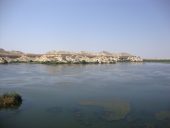
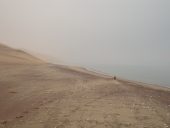
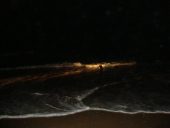
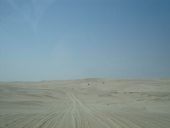
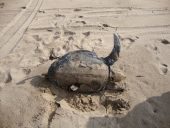
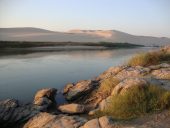
2 Comments
Join the discussion and tell us your opinion.
Wow! Scary but I am sure worth it.
Achingly beautiful scenery, especially near the Cunene mouth.
Good to see that there are still some people in the world prepared to be adventurous – wel ldone !